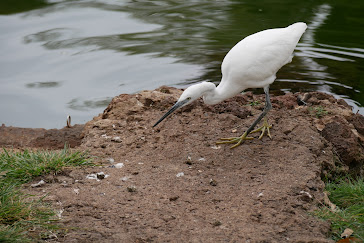A fotografia da vida selvagem é o ato de tirar fotos de animais, plantas ou, às vezes, paisagens. Há seis anos descobri o prazer de fotografar a natureza, principalmente de aves e insetos. Isso permitiu-me ter, instantaneamente, um olhar mais próximo da natureza e vontade de partilhá-la.
A fotografia da vida selvagem faz com que passemos mais tempo na natureza e pode ser muito gratificante quando a foto dos nossos sonhos é tirada. Mesmo que, muitas vezes, possa ser frustrante quando, após um longo dia, nenhuma foto é boa o suficiente!
 |
| Gaivina-comum, Funchal, T.Quartier |
Podemos dividir a fotografia da natureza em dois ramos principais:
Fotografias naturalistas que mostram claramente o ser vivo no seu habitat, ou suas características. Este tipo de fotografia mostra detalhes mais difíceis de observar ou comportamentos interessantes e são de interesse naturalista. Com este propósito, são precisas boas condições de luz, distância próxima ao animal e um comportamento natural do mesmo.
.JPG) |
| Agalenatea redii, Funchal - T.Quartier |
Por outro lado, a fotografia da vida selvagem também pode ser uma forma de trazer a arte para a natureza, usando as particularidades do sujeito da fotografia, a luz e o habitat circundante para obter uma imagem mais artística. Pode usar-se a luz de fundo ou o efeito de simetria e explorar as cores que se pretendem salientar. Também-se pode obter uma composição geral original.
 |
| Himantoglossum hircinum, Osenbach - T.Quartier |
Acredito que estas duas formas de fotografia podem despertar o interesse das pessoas pela natureza, tanto enquanto se pratica a fotografia como, depois, apreciando as fotografias. Por resta razão, a fotografia poderia ser usada como uma ferramenta de educação ambiental, por exemplo.
Aqui na Madeira, a fotografia da natureza é uma atividade que podemos usufruir em qualquer lugar: perto da costa, nas montanhas nubladas ou na floresta Laurissilva. Podem ser encontradas muitas espécies, habitats e atmosferas diferentes. Explorar a Madeira dá a oportunidade de obter imagens muito variadas!
 |
| Bico-de-lacre-comum, Machico - T.Quartier |
Wildlife photography is the act to take pictures of animals, plants or sometimes landscapes. Six years ago I discovered the pleasure to take photographs of nature, especially of birds and insects. It gave me instantly a closer look to nature and the will to share it.
Wildlife photography makes you spend more time
in nature and can be very satisfying when your dream picture is taken, even
though it can be so frustrating when, after a long day, no picture is decent
enough!Ischiodon aegyptius, Funchal, T.Quartier
Wildlife photography can be divided into two
branches:
Naturalistic photographs which clearly show the
living being in its habitat, or its characteristics. These kinds of pictures
show hidden details or interesting behavior and are of naturalistic interest. For
this purpose, you will generally need good light conditions, close distance
with the subject and a natural behavior of the animal.
But wildlife photography can also be a way to
bring art into nature, by using the particularities of the subject, the light
and the surrounding habitat to get a more artistic picture. You can use
backlight or symmetry effect and exploit colors you want to show. You can also obtain
an original overall composition.Meliteaea athalia, Osenbach, T.Quartier
I believe these two forms of nature photography
can raise people’s interest in nature, both by practicing photography and
enjoying the pictures. This is why photography could be used in environmental
education, for example.
Here in Madeira wildlife photography can be
enjoyed everywhere: near the shore, in cloudy mountains or in Laurissilva
forests, lots of different species, habitats and atmospheres can be
encountered. Going across Madeira will help you to obtain very varied pictures!

.JPG)




.jpg)





.jpg)



.jpeg)

















.jpg)



